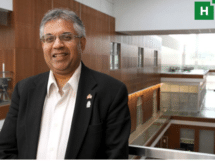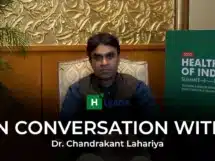As coronavirus fatalities in India point finger at the burden of existing non-communicable diseases, a leading endocrinologist Prof. Mohd Ashraf Ganie lays emphasis on crushing the COVID-19 curve instead of just flattening it.
India, the second-most populous (1340 million) country in the world holds a significant burden of non-communicable diseases (NCDs) with about 257 million cases of hypertension (HT), 65 million of diabetes mellitus (DM), and 29 million cases of cardiovascular diseases (CVDs). A report released by the World Health Organisation in 2018 too reveals that NCDs are responsible for about 5.8 million deaths in India annually.
With the country that’s already overburdened with NCDs, the outbreak of COVID-19 pandemic has posed a double threat. Keeping in view India’s vulnerability to epidemics in the past and the most recent COVID-19 episode, Dr. Mohd Ashraf Ganie, Professor at Department of Endocrinology at Sheri-Kashmir Institute of Medical Sciences Srinagar, insists that there is need to not flatten but crush the curve.
In an interview with HealthLEADS, Prof. Ashraf, who is also President MP PCOS Society and former Associate Professor Endocrinology AIIMS, New Delhi, emphasises that considering early transmission dynamics from China and the optimistic projections proposed by Imperial College London, at least 5 percent Indians are likely to be affected in the coming 2-3 months if strict measures are not adhered to.
Prof. Ashraf talks at length about the need to use creative ways to mobilise the nation’s resources to tackle the pandemic.
Edited excerpts:
What additional steps can be taken to mobilise and organise the nation in this war against COVID-19?
In accordance with the WHO guidelines for containment of COVID-19 (widespread testing, quarantine of cases, contact tracing, and social distancing), the Government of India(GoI) has already taken many steps, with the recent nation-wide lockdown being a major step towards curbing the community spread. Besides, India has taken a host of public health measures (handwashing, respiratory etiquette, and banning large scale public gatherings) using mass-media campaigns, liberal testing, intense contact tracing, and augmentation of health infrastructure (training of manpower, adding ICU beds and another 40,000 ventilators) in this direction.
Although these efforts by the Government are laudable, a surge in migrant worker exodus on a large scale and fall in the economy may pose a significant impediment. The key question remains, whether all these measures can alleviate mortality in a population already having an epidemic of NCDs, a high-risk group for Covid19? However, we can suggest some more measures to tackle the further spread after lockdown, is opened. These could be as follows:
i) Making more diagnostic tests available:
There is a need to use creative ways to mobilise the nation’s research laboratories to assist with population screening (especially all those who are symptomatic), create/divert funds towards this aspect. Though we are able to have better control as compared to the other European countries, this is too early to comment on it especially, because only 70 percent of testing capacity has been used till 5 April (70, 000 tests RT PCR), at 132 state-run labs and 52 private labs. Without increasing our diagnostic capacity, we cannot trace the scope of the outbreak. This is further supported by the success of countries like Singapore, South Korea in limiting the spread of COVID-19 even without complete lockdown.
ii) Stratification of infected people:
We can stratify COVID-19 cases in four categories.
a) Confirmed cases (symptomatic and confirmed with RT-PCR, the current methodology of testing.
b) Suspected cases (symptomatic and exposed but who tested negative): These 2 groups require complete isolation and must be looked for warning signs (like shortness of breath, respiratory rate, RR>30/m, oxygen levels in the blood, SaO2<93%) because these ones may need hospitalisation (nearly 15 % of COVID-19 affected are expected to reach this stage) and intensive care.
c) Exposed cases (who came in direct contact of Covid 19 cases): These need isolation for at least 14 days and may need testing if they develop symptoms.
d) Vulnerable cases: (not symptomatic, not exposed but high risk of developing severe disease if infected). These people may have high mortality as per Chinese statistics. So, it is necessary to direct our health measures to this group (through involving voluntary organisations to provide them, necessary medicines, optimisation of their co-existing illness through telemedicine, awareness about warning signs and need of testing if they develop symptoms through social media and health workers.
e)Recovered cases: These people are now having adequate immunity and can be a potential group that can play a major role in our battle against COVID- 19.
How can the recovered cases play a major role in this fight against COVID- 19?
The people who got infected and recovered – be it after a asymptomatic or mild or severe symptomatic disease are now having adequate immunity and can be potentially used in several ways such as, they can liberally venture in the community. These people can be allowed to go safely to their work and run various areas of the economy. But, again, they have to be tested liberally and the current RT-PCR test won’t be the ideal one. It would be a simple, cost-effective, point of care blood test to detect antibody.
The affected and recovered cases in India are less, however, it is likely to be more if we adopt European and Chinese statistics.
As extrapolated by conservative estimates, it may increase to a significant number (approximately 67 million) in the next 2-3 months as suggested by early transmission dynamics in China and the optimistic projections proposed by Imperial College London. Thus, this concerted and determined approach and guided by science, can help us to begin and revive businesses of all kinds, including airlines, hotels, restaurants, and entertainment venues.
Secondly, these recovered patients can be scientifically evaluated to see factors helping in recovery from COVID-19.
Also, most importantly, these people may serve as a source of plasma therapy which may be suitable for severe and critically severe patients with rapid disease progression as advised by the China National Health Commission (NHC) in the seventh edition of guidance for COVID-19 diagnosis and treatment.
Can schools, colleges (educational institutes) safely reopen?
It depends on the role of children as transmitters of the virus to their teachers, parents, and grandparents. Qiu and colleagues showed children accounted for roughly 5 percent of total patients with COVID-19 in China. Though children are susceptible to SARS-CoV-2 infection, they frequently do not have a disease (none developed severe disease or death in age group <9 years), raising the possibility that children could be facilitators of viral transmission.
If children are important in viral transmission and amplification, social and public health policies (e.g., avoiding interaction with elderly people, closure of schools and use of digital tutorial services to educate them at home) could be established to slow transmission and protect vulnerable populations.
How safe is it for others to return to work?
It depends on several factors such as level of ongoing infection, nature of possible exposure at the workplace, reliable screening and rapid detection of new cases, etc.
India reported nearly 5000 infected cases with 140 deaths on April 5, 2020. Though this data looks very respectable if we compare it with China, USA and, European countries, we cannot ignore our low testing rate for the same.
According to the latest estimate about the severity of COVID- 19 in China-model based analysis, after adjusting for censoring (including those having symptoms, exposure but tests could not be done due to limited capacity), demography and under ascertainment (included all those who traveled from China to their home countries during that time), case fatality rate was estimated nearly 1.38 percent (with 0.38% in age < 60 years and 6.38% in > 60 years of age group). By applying these results in the Indian context, with deaths of about 120 till 5th April, it is likely that nearly 90,000 people are currently infected, suggesting the need of increasing testing with limited mobility of people preferably, to work from home, if possible or stratification of staff for next 1-2 months, avoiding going office if they are sick, maintaining social distancing strictly like Singapore did (no complete lockdown) and safely redeployment of those who have recovered completely. Otherwise, we may need several months to get a system in place. Also, antibody testing in asymptomatic cases may make the task much easier.
Since mortality rate in case, of COVID-19 is quite high among the elderly and people having diabetes, heart ailments, hypertension, and respiratory illness, how do you think it will affect our country that’s already burdened with these disorders?
India, the second populous country in the world has a significant burden of non-communicable diseases (NCDs) amounting to nearly 257 million with hypertension (HT), 65 million with diabetes mellitus (DM), and 29 million with cardiovascular disease (CVD). With all the caveats in extrapolating data from China and Italy to India, there can be 38.7 percent severe and 58.2 percent critically ill cases among COVID-19 cases with underlying chronic illnesses as compared to 27 percent without comorbidities. The reported series show HT (15 %), DM (7.4 %), and CVD (2.5 % ) as common associated illnesses with respective case fatality rates (CFRs) as 10.55 percent in CVD, 7.3 percent in DM, and 6 percent in HT patients, respectively.
Considering early transmission dynamics from China and the optimistic projections proposed by Imperial College London, at least 5 percent Indians are likely to be affected in the coming 2-3 months, if strict measures are not adhered to.
On the basis of these modeling projections, a total of 67 million COVID-19 cases are likely to occur in India with 10 million (15%) having severe and 3.3 million (5%) critical illness.
Extrapolating from the published data, out of critically sick 0.025 million with DM, 0.087 million with HT and 0.01 million with CVD are likely to succumb to their illness on the basis of average mortality of 60 percent ( shown by Wu Z and others in The Lancet).
Based on estimates of CFRs of 0.2 to 7.7 percent reported and early recognition and intervention strategies in place as suggested by Sun Q et al in Jiangsu Province and of complete lockdown (as per paper by Lau H et al in Wuhan) India may suffer 0.134 million deaths (with 0.073 million with co-existing illness).
These are the conservative estimates and taken as the best case scenario (0.2 % CFR) among COVID- 19 subjects. Thus, the need is to not flatten but crush the curve.
What is the consensus on methods of virus spreading ?
In an earlier report (March 16, 2020) published by WHO, it was considered that coronavirus is airborne and stay suspended in air, for about 8 hours depending on environmental factors like heat, humidity, for about 2 hours on copper, steel, and 3-4 hours on paper, plastic, etc.
But, according to the latest report (as updated on March 28, 2020) it has been concluded that the deadly virus is not airborne but is mainly transmitted through droplets generated when an infected person coughs, sneezes or speaks. These droplets are too heavy to hang in the air and quickly fall on floors and surfaces. So, it is necessary to educate all especially, children to follow social distancing (at least 1-meter distance from other schoolmates, teachers), regularly disinfecting surfaces that are touched frequently like working desks, chair, regularly cleaning your hands and avoid touching eyes, mouth and, nose.


















Add Comment